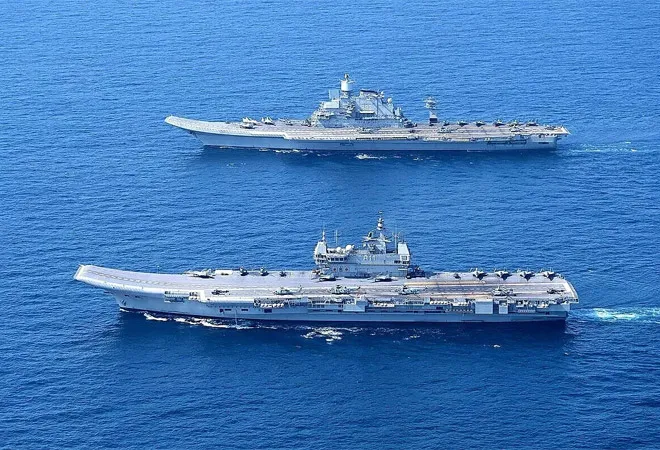
In perhaps its most extensive display of operational capability in recent years, the Indian Navy conducted what it described as, “a coordinated deployment of more than 35 aircraft in the Arabian Sea” early last month. The mission included two aircraft carriers, multiple warships, submarines, and in excess of 35 frontline planes amidst
China’s increasing forays into the Indian Ocean.
The exercise represented a major milestone in the Indian Navy’s quest for heightened maritime security and power projection capability in the Indian Ocean Region (IOR) and beyond. To truly appreciate its strategic significance, however, it must be viewed against the backdrop of the Pakistan Navy’s augmentation of its surface fleet in recent years.
Pakistan’s build-up
While
Pakistan’s submarine acquisition plans are frequently discussed in India’s maritime circles, the country’s augmentation of its navy’s surface fleet has largely eluded the attention of New Delhi’s naval mandarins, despite indicating Islamabad’s new ambition to enhance its navy’s ability to project power in the IOR.
The exercise represented a major milestone in the Indian Navy’s quest for heightened maritime security and power projection capability in the Indian Ocean Region (IOR) and beyond.
For instance, consider
the Zulfiquar-class frigates—also called F-22P frigates—which the Pakistan Navy commissioned in 2009. Modelled on the 2200-2500 tonne-class Chinese Type 053H3 frigates, operated by the People’s Liberation Army Navy, these ships predate the considerably larger Tughril-class (Chinese Type 054A) frigates manufactured subsequently for the Pakistan Navy. The Pakistan Navy presently operates four Zulfiquar-class frigates, with the first three built in China, and the remaining vessel—
PNS Aslat—constructed in Pakistan through transfer of technology (see Figure 1). Not designed for any specified role, these are multi-mission guided missile frigates that can conduct anti-submarine warfare as well as anti-surface warfare (ASUW). They can additionally be utilised in an air defence role.
Figure 1: Pakistan Navy ship PNS Aslat during a goodwill-cum-training visit to Saudi Arabia in February 2018
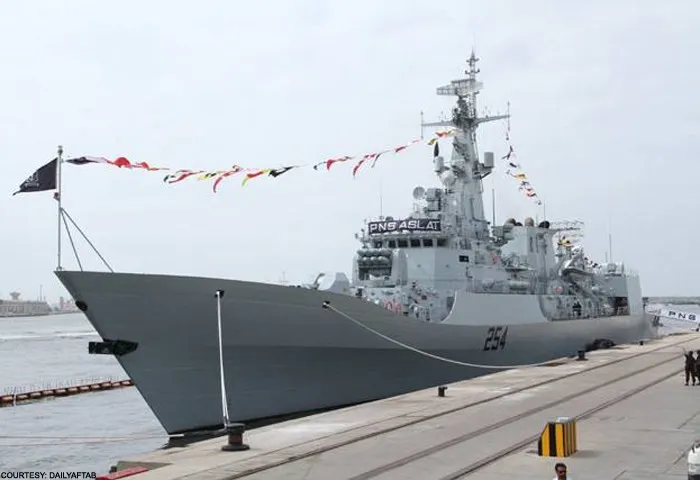 Source: Business Recorder
Source: Business Recorder
The multi-mission characterisation is also true for the technologically superior 4,000 tonne displacement Tughril-class stealth frigates, although with enhanced air defence capabilities. Two of these—PNS Tughril and PNS Taimur—were commissioned into the Pakistan Navy in 2022, and the remaining two—
PNS Tippu Sultan and PNS Shah Jahan—in May 2023 (see Figure 2).
Figure 2: Pakistan Navy ship PNS Tippu Sultan at the Port of Colombo on a formal visit in June 2023
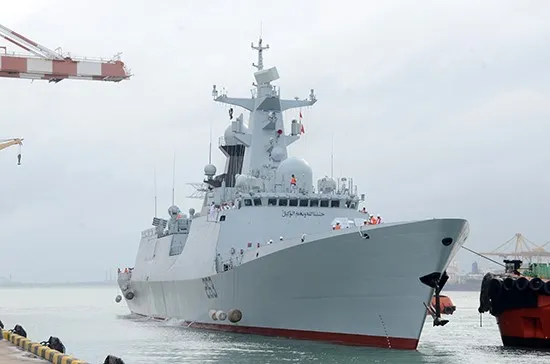 Source: Colombo Gazette
Source: Colombo Gazette
As the author had discussed in a recent
brief, the Tughril-class—with its long-range missiles, improved radar and electronic warfare suite, and sensors—was developed by the Chinese to boost both air defence as well as ASUW capabilities. When operated with the Pakistan Navy’s MILGEM/Jinnah-class corvettes, offshore patrol vessels (OPV 1900), and CH-4 medium-altitude long-endurance drones, the Tughril-class is aimed at enhancing the Pakistan Navy’s footprint in the IOR rather than remaining limited to coastal defence and sea denial during war.
The Arabian Sea drill
The mega exercise involved the Indian Navy’s aircraft carriers, INS Vikramaditya and the recently-commissioned INS Vikrant, as its mainstay. The flagships served as mobile airfields for a broad variety of aircraft such as the MiG-29K fighter aircraft (see Figure 3) and helicopters like the MH60R, Kamov, and Advanced Light Helicopters.
Figure 3: The mega operation involved two aircraft carriers, multiple warships, submarines, and over 35 frontline planes
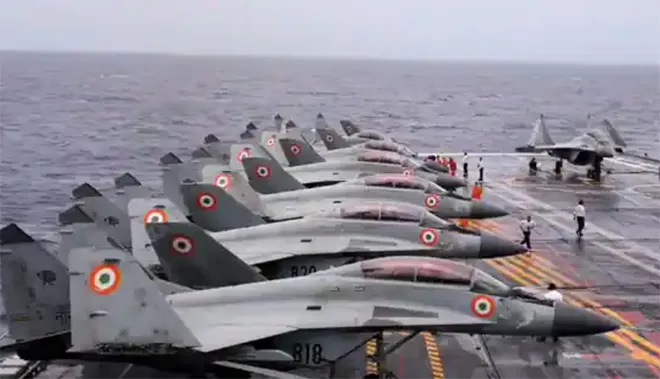 Source: Hindustan Times
Source: Hindustan Times
The drills demonstrated smooth integration of the two aircraft carriers operating with a varied flotilla of ships, submarines, and aircraft, displaying India’s technological acumen in the maritime domain. The skilful display underscored New Delhi’s commitment to protecting India’s national interests, preserving regional stability, and fostering collaborative ties in the maritime sphere. Notably, these were the first mammoth drills with the two aircraft carriers in participation post the induction of the indigenously-constructed INS Vikrant in September 2022 (see Figure 4).
Figure 4: Both the aircraft carriers operated by the Indian Navy feature modern technology – similar long-range radars, same fighter jets, sensors, and a matching aviation complex
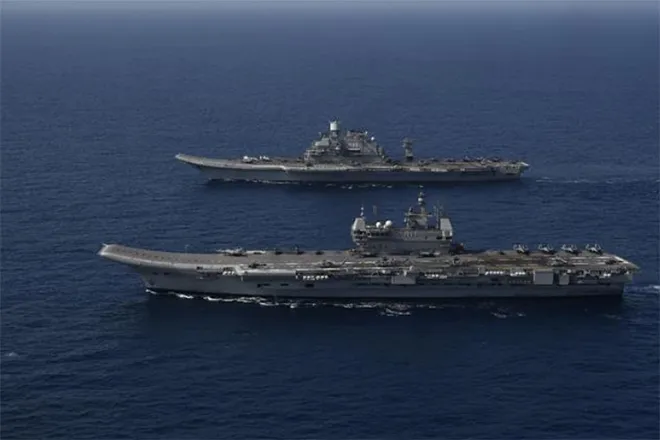 Source: The Tribune
Source: The Tribune
The drills validated the Indian Navy’s flexibility in situating the aircraft carriers in the vast expanse of the IOR and beyond. This provides enhanced operational manoeuvrability, prompt reaction to emerging challenges, and sustained deployment of air power to protect India’s interests across the world; it serves consequently as a convincing testament of the centrality of sea-based air power in sustaining sea control. In this context, Indian Navy Spokesperson Commander Vivek Madhwal aptly mentioned that, as India continues to buttress its security architecture, “
the significance of aircraft carriers will remain paramount in shaping the nation’s defence strategy and promoting regional stability.”
Conclusion
While Pakistan’s augmentation of its navy’s fleet of surface combatants is significant, their numbers and capabilities are not yet sufficient to credibly challenge the Indian Navy’s control of the high seas. Although the Pakistan Navy’s interest in novel technologies and weapons systems is notable, the Indian Navy maintains sizeable numerical superiority and wields much better capabilities, as was on show during the Arabian Sea exercise.
The skilful display underscored New Delhi’s commitment to protecting India’s national interests, preserving regional stability, and fostering collaborative ties in the maritime sphere.
For all its soaring ambitions, therefore, the Pakistan Navy has long remained a defensive force and will likely continue as such over the foreseeable future. Given its stated aims to protect Pakistan’s maritime interests, deter aggression at and from the sea, provide disaster relief, participate in the development of coastal communities, and contribute to global efforts in maintaining a good maritime order, the core of the Pakistan Navy’s approach will remain reliant on the enhancement of its Anti-Area Access-Denial (A2/AD) capabilities. These would aim to limit and delay the enemy and deny them a free hand, using platforms like those belonging to the Tughril-class.
Nevertheless, the Indian Navy must monitor the shift in the Pakistan Navy’s maritime strategy, which has, in recent years, begun to aspire for increased and lasting presence in the IOR rather than remaining limited to coastal defence and sea denial during war. From a force adopting an offensive sea denial strategy, which required the supremacy of submarines and missile-carrying maritime patrol aircraft, the latter is now gearing towards enhanced power projection in the IOR with the periodic induction of surface vessels of higher displacement and featuring the required capabilities.
Aditya Bhan is a Fellow at Observer Research Foundation.
The views expressed above belong to the author(s). ORF research and analyses now available on Telegram! Click here to access our curated content — blogs, longforms and interviews.



 In perhaps its most extensive display of operational capability in recent years, the Indian Navy conducted what it described as, “a coordinated deployment of more than 35 aircraft in the Arabian Sea” early last month. The mission included two aircraft carriers, multiple warships, submarines, and in excess of 35 frontline planes amidst
In perhaps its most extensive display of operational capability in recent years, the Indian Navy conducted what it described as, “a coordinated deployment of more than 35 aircraft in the Arabian Sea” early last month. The mission included two aircraft carriers, multiple warships, submarines, and in excess of 35 frontline planes amidst 



 PREV
PREV


